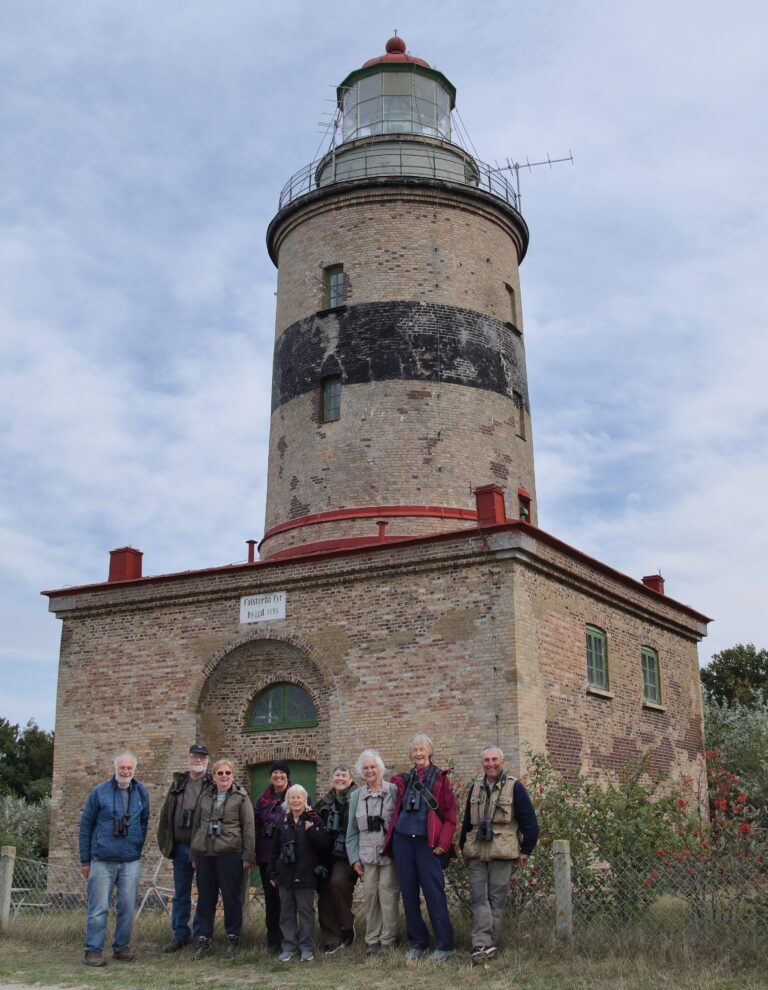
After crossing the famous Öresund bridge from Copenhagen, we arrive in breezy Höllviken at the ‘neck’ of the Falsterbo peninsula. On a short walk from the hotel, bird ‘number one’ is a Sparrowhawk, zooming by overhead, followed shortly after by White Wagtail and Hooded Crow in the hotel grounds. Along the shore, battered by breakers, a Kestrel hovers nearby and a Mink takes the plunge from the beach to swim across the sheltered harbour to its hideout in a crevice in the stone jetty. On the return leg through the pines, we find a cute Red Squirrel peering at us from behind a tree trunk, with its tail jutting out on the other side, and spot Spotted Flycatcher back in the hotel grounds.

This morning we begin at the Falsterbo lighthouse, Sweden’s oldest, built in 1795, where several Yellow Wagtails on the golf course greens are ‘early birds’, along with a dashing Hobby. Five minutes later at 8.40am we add Marsh Harrier, patrolling the dunes, along with a Kestrel at 8.42, an Osprey heading purposefully south at 8.47 and the first of so many Sparrowhawks zooming all around us from 8.50 onwards.

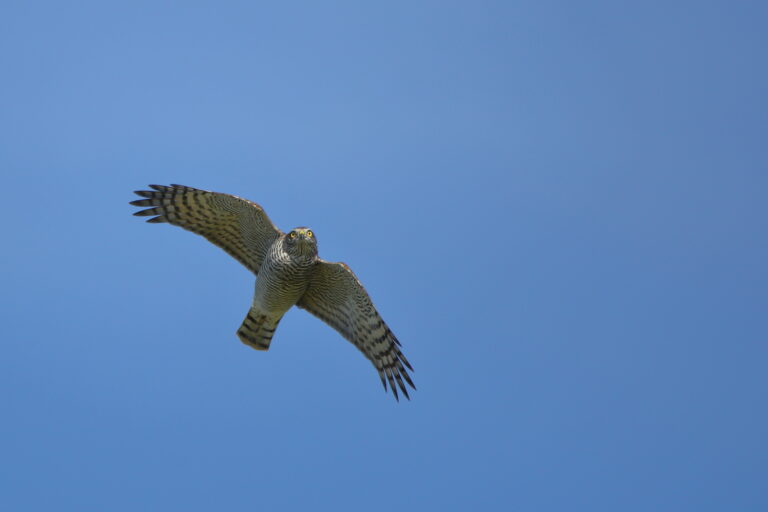
Just after nine a small flock of Tree Sparrows drops into a clump of ubiquitous Beach Roses, a male Wheatear hops around beside the path and an immature White-tailed Eagle ‘sails’ by along the shore at 9.11, with three Sandwich Terns just offshore and an incoming flock of six Great Egrets from across the sea. Our varied list continues to grow with Common Gull, Stock Dove, Tree Pipit and Siskin, while a female Merlin makes a magical appearance at 9.28. By 9.43 we arrive at the southern tip of the Falsterbo peninsula called Nabben, where the raptorfest continues with a Peregrine lying prone on a sand bar to avoid being blown away by the stiff breeze, while we are blown away by a tally of eight different raptors in just over an hour!
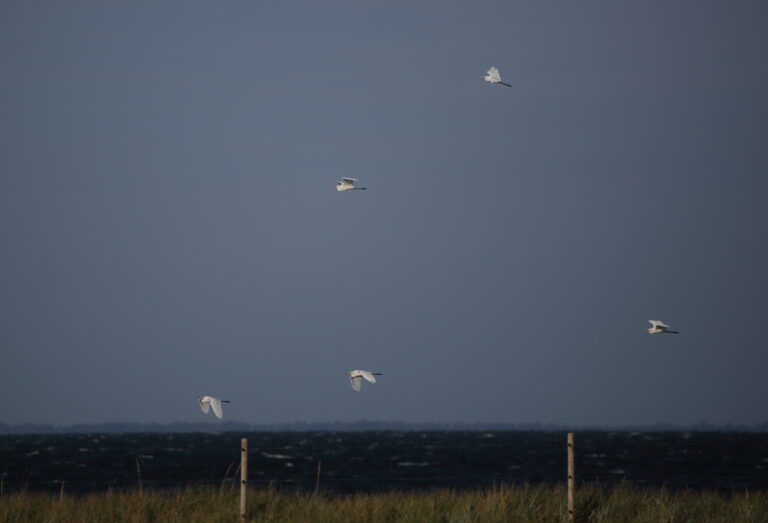
The lagoon at the point provides a ‘smorgasbord’ of waterbirds including Shelduck, Shoveler, Wigeon, Pintail, Teal, Goldeneye and Pochard, along with an impressive variety of waders from Curlew down to Little Stint, with all shapes and sizes in between including Oystercatcher, Grey and Ringed Plovers, Lapwing, over forty Avocets, numerous Ruff and Dunlin, plus Snipe, Greenshank, Redshank, Spotted Redshank, Wood and Curlew Sandpipers, and best of all, a close range view of a Broad-billed Sandpiper! During our watch, the many waterbirds repeatedly erupt skywards each time the Peregrine makes a dashing raid across the lagoon. Along the shore, with Eiders bobbing on the waves and a Grey Seal poking its head above the surf, the waderfest continues with Whimbrel, Sanderling and Turnstones, all feeding amongst the wrecked seaweed lying along the windswept beach.
After lunch in the genteel centre of Falsterbo village, we head north to explore the Flommens nature reserve, where new birds include Barnacle Geese, Common Sandpiper, Black-tailed Godwit and Reed Bunting. As well as a mini murmuration of Starlings, the lagoons here produce a tally of around 100 Snipe, all feeding in plain sight!
We end the day at Ljungen where the wide open heath often attracts thermaling raptors, but not today, thanks to the very strong wind, but on the leeward side of the waving birches at the edge of the heath, we enjoy the spectacle of hundreds of Swallows and House Martins, cashing in on a windfall of insects dislodged from the wind battered trees. That’s 71 different birds today. Not bad for a quiet day by Falsterbo’s standards!
What a difference a day makes as yesterday’s brutal wind has died down and the sea is flat calm. Arriving at the lighthouse again it is eerily quiet first thing this morning, with just a few wagtails on the golf course and only one Sparrowhawk! Meanwhile, a bird ringer emerging from the bushes beside the lighthouse kindly shows us a Robin caught in one of the mist nets.
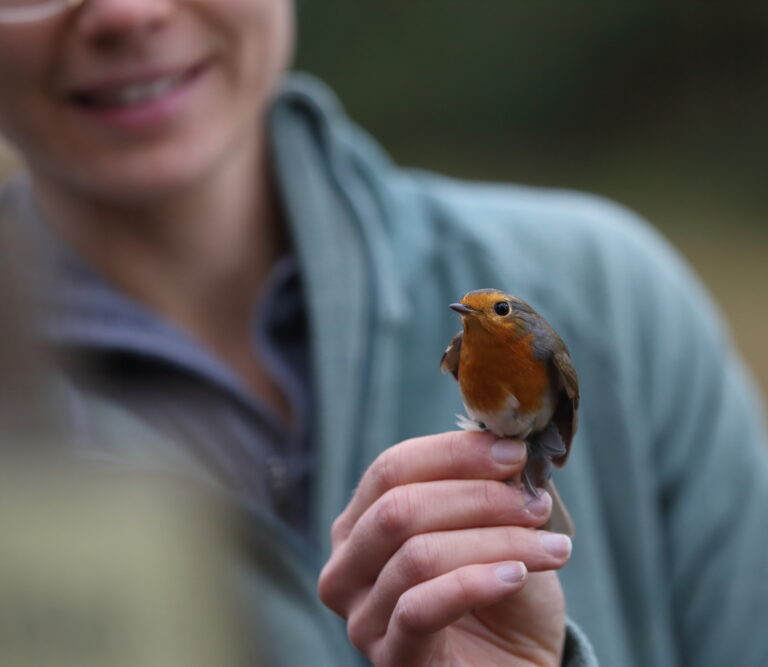
On the way to the point Falsterbo’s eclectic bird mix includes Tree Pipit and Sandwich Tern, and we add Bar-tailed Godwit to the trip list at the lagoon. Other sightings here include one Whimbrel, two Spotted Redshanks, three Wood Sandpipers and close views of a Dunlin feeding amongst a group of 26 Little Stints, while a Water Rail squeals from within the nearby reeds.
As the sun breaks through and the air warms, a swarm of Swallows and Sand Martins with one Swift feeding low over the reedbed is a joy to watch, and we also add Skylark to the list here. On the way back to the lighthouse a smart Whinchat poses on a fence wire, and a scan from the beach produces cracking views of a Red-necked Grebe in stunning breeding plumage, with a deep yellow bill, and looking resplendent with the sun shining from behind us.
After lunch back in the village, we return to the heath at Ljungen, where Green Woodpecker is another new sighting. Further on we find a fine specimen of the Queen of Spain Fritillary, and at long last, our first Honey Buzzard, a dark juvenile being harried by a smaller Kestrel. Further still, we find dozens of Yellow Wagtails feeding around cattle, including a bright male of the central European flava race with a blue-grey head and white supercilium. In the birches at the edge of the heath we also find Spotted Flycatcher and an Icterine Warbler, with a breast as bright yellow as the male Yellow Wagtail. The bases of these old birches also provide liquid refreshment for an extraordinary assembly of Red Admirals, ants, iridescent emerald green flies, wasps and a hornet; a phenomenon I have certainly never seen before!
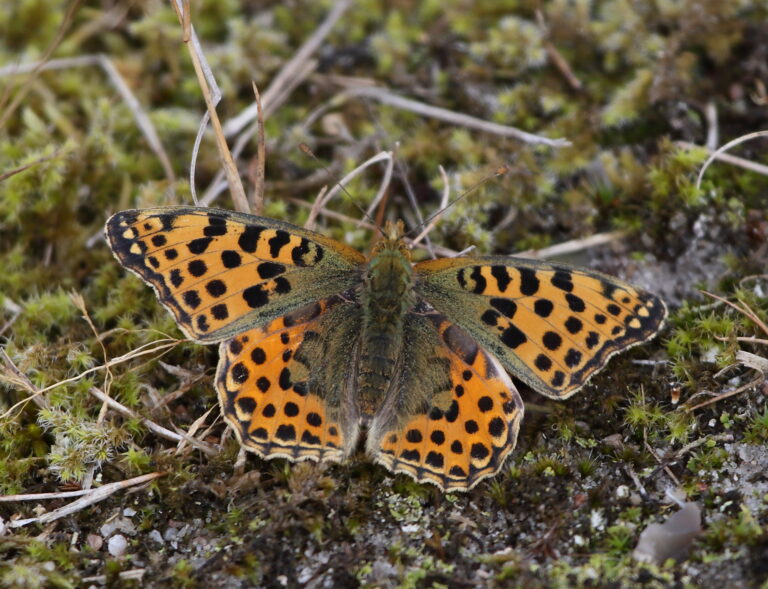
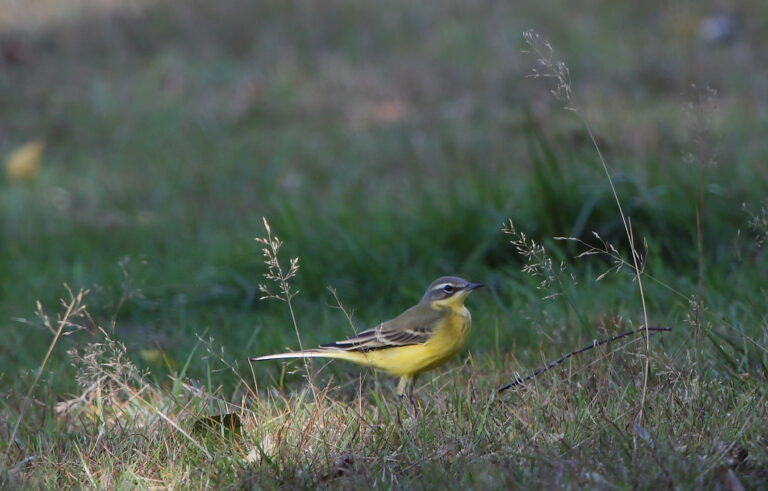
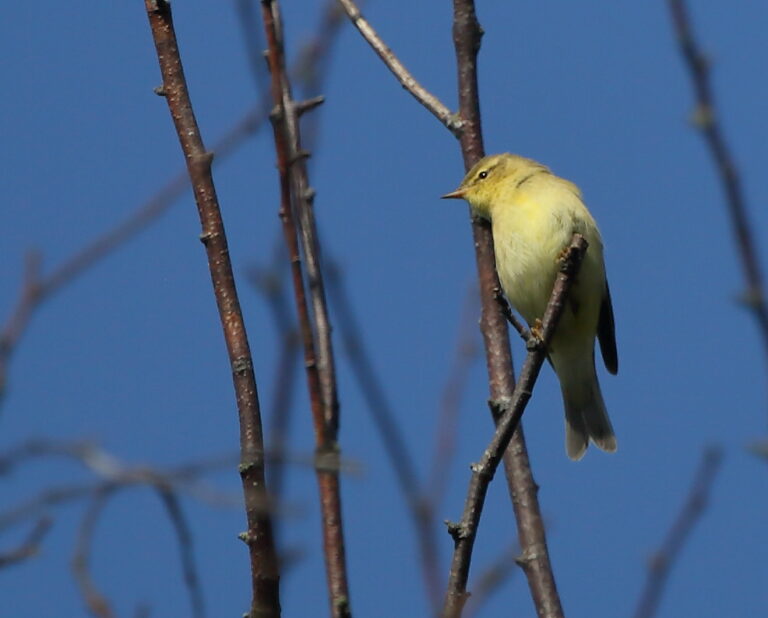
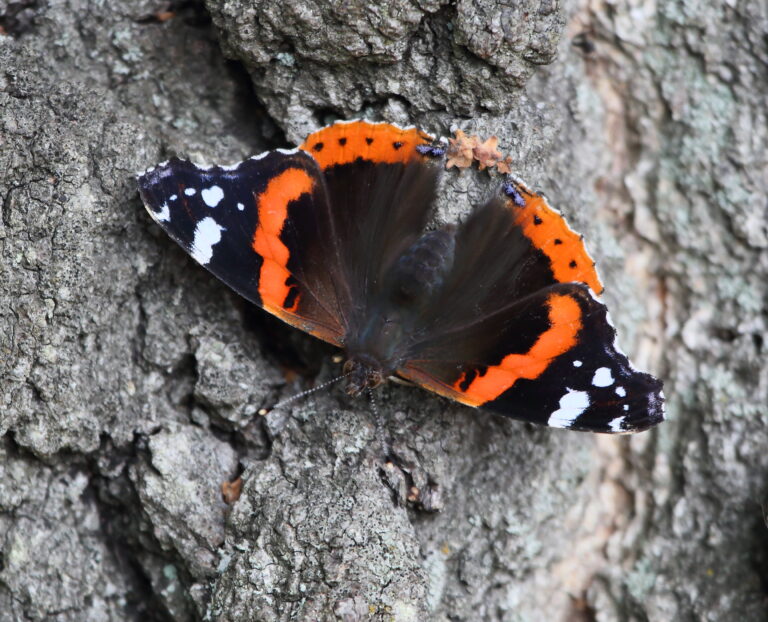
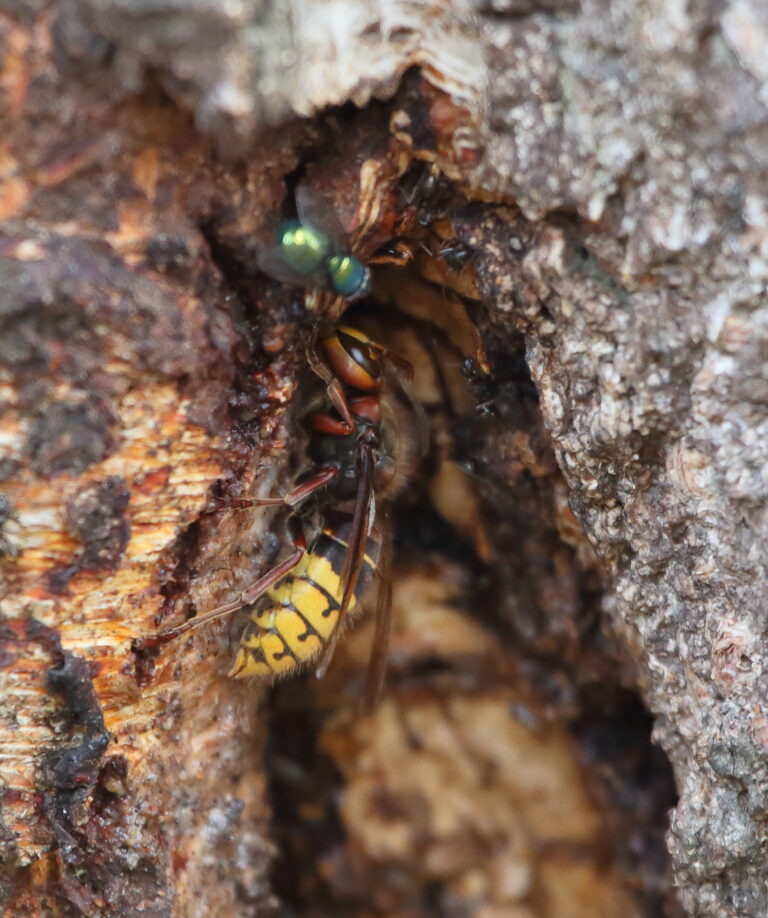
We end the afternoon with a spot of raptor watching from the edge of the heath, and in a productive half hour we see Kestrel, Hobby, two impressive White-tailed Eagles, circling one another, and a soaring Goshawk, which is raptor number ten for the trip!
Today we head inland and begin with a visit to Hardeberga, where the quarry is home to a pair of Eagle Owls, but despite a thorough search of the ledges, the owls are nowhere to be seen so we make do with lovely views of a Red Kite in lazy flight below our vantage point, and a Raven perched on the top of one of the quarry buildings.
A little further east is Krankesjön, a large reed fringed shallow lake surrounded by a forest of oak, beech and pine, and amid the tall trees we enjoy views of several Marsh Tits, the Scandinavian europaea race of Nuthatch, with white breast and belly, the caudatus north European white-headed race of Long-tailed Tit and a flighty Black Woodpecker.

The lake is even more productive with hundreds and hundreds of noisy Greylags, plus well over a dozen Great Egrets, about four Ospreys, a couple of Hobbies, busy chasing dragonflies, one or two Marsh Harriers, and a high-flying Goshawk along with an impressive Caspian Tern, with a carrot-like red bill, flying back and forth in front of one of the viewing platforms, while a calling Penduline Tit remains hidden in the reeds. Back at the vehicle, we find a tiny vole and humungous Roman Snails.
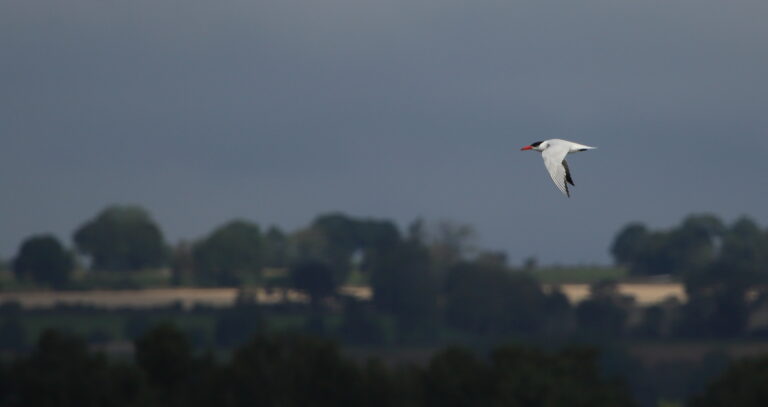
After lunch overlooking the lake, we move on to the open rough meadows of the nearby Vomb nature reserve, where a ring tail Hen Harrier shows really well as it slowly patrols the ground at very low level. Other sightings here include another Red Kite, another Hobby and several Kestrels, which are so common here.
We end the day at a small marsh near Börringe, hoping to find a recently sighted vagrant Pectoral Sandpiper, but with no sign of any birders here, or the bird itself, we assume it must have moved on, while a Buzzard perched on a post, brings the trip list to 102 different birds in just four days, with 22 species of wader, including a Broad-billed Sandpiper, and 13 different raptors, from White-tailed Eagle to Merlin, plus Caspian Tern, Black Woodpecker, Icterine Warbler and the super Red-necked Grebe.
